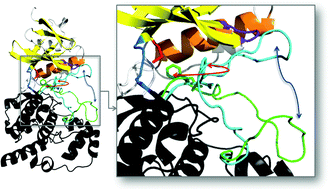Insight into the selective inhibition of JNK family members through structure-based drug design†
Abstract
The c-Jun N-terminal kinase (JNK) family, which comprises JNK1, JNK2 and JNK3, belongs to the mitogen-activated protein kinase (MAPK) superfamily, whose members regulate myriad biological processes, including those implicated in tumorigenesis and neurodegenerative disorders. As with many other kinases, JNKs can adopt two main conformational changes: the DFG-in (active) conformation and the DFG-out (inactive) conformation; however, to date, the only resolved DFG-out conformation is that of JNK2. Structural elucidation of the remaining DFG-out conformations will be critical for structure-based drug design of novel type II inhibitors, which have been shown to offer greater therapeutic benefit than do type I inhibitors, as demonstrated by imatinib in chronic myeloid leukemia. Herein we report the use of a homology-modeling approach to build models of the DFG-out conformations of JNK1 and JNK3. After validating the model structures, we used structure-based drug design to elucidate the principal structural differences among the three JNK active sites and the binding of known JNK inhibitor, and to explain the selectivity of this compound for JNK2. Our findings provide structural guidelines for the design of novel and selective type II JNK inhibitors.


 Please wait while we load your content...
Please wait while we load your content...